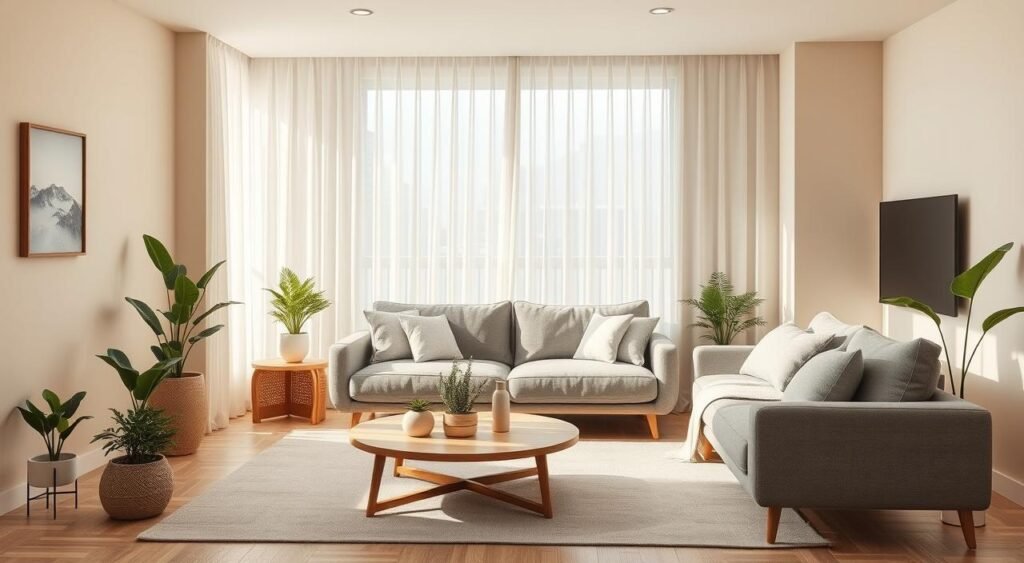What if I told you neutrals could be bold? Let’s challenge the notion that a neutral color palette for interiors is dull. Modern interior design now reinvents neutrals, combining warm browns with edgy black accents or cool grays with dusty pinks. Your modern home deserves more than just beige! I aim to show how neutrals like Sherwin Williams’ Repose Gray or Benjamin Moore’s Gray Owl can create spaces that are both timeless and exciting.
Imagine a living room where Farrow & Ball’s Wimborne White meets trailing greenery, or a bedroom where Behr’s Greige balances a cool olive sofa. Neutral color palettes today are dynamic, not one-size-fits-all. Whether you desire the cozy warmth of honeyed oak or the crisp edge of navy and white, there’s a neutral scheme for every style. Let’s explore how these colors work together to build spaces that feel serene yet sophisticated.
Key Takeaways
- Neutrals like Benjamin Moore’s Sea Pearl or Behr’s Soft Linen offer endless modern design possibilities.
- Layer textures—wood, plants, metals—to make neutral rooms feel alive, not flat.
- Brands like Sherwin Williams (Agreeable Gray) and Farrow & Ball (Railings) provide expert color options.
- Pair warm tones (like Benjamin Moore’s Kona) with cool accents (Behr’s Silver Drop) for balance.
- Even small pops of plum or dusty pink (Behr’s Nature’s Gift) add drama without overwhelming.
Ready to rethink what neutrals can do? This guide breaks down how to mix, match, and master the neutral color palette for interiors—no design degree required. Let’s turn your modern home into a space where calm meets sophistication, one shade at a time.
Understanding the Power of Neutral Color Palettes
Let’s dive into the essence of neutral color palettes for interiors. They’re not just about “boring beige walls.” Instead, they form the cornerstone of enduring interior design, merging elegance with practicality. Hues such as whites, grays, and terracottas serve as blank canvases. They allow light and texture to take center stage. Are you ready to redefine your perception of neutrals?
What Defines a Neutral Color in Interior Design
Neutrals extend beyond the realm of basic whites and grays. Consider muted sage greens, soft terracotta, or even charcoal blacks. These colors eschew boldness yet provide depth. For instance, a dusty blue can serve as a room’s anchor without dominating it. The essence lies in their ability to act as unifying elements within any color scheme.
| Neutral Shade | Design Role | Example Use |
|---|---|---|
| Warm White | Enhances natural light | Wall paint in sunlit rooms |
| Muted Olive | Adds organic warmth | Curtains or upholstery |
| Charcoal | Creates drama | Accent walls or furniture |
The Psychological Impact of Neutral Spaces
Why do 75% of homeowners gravitate towards neutrals? They calm the mind. Soft taupes can reduce stress, while crisp whites can make small rooms appear larger. Picture a gray living room—its balanced energy fosters relaxation. Even subtle texture contrasts, like linen versus wood, enhance coziness without the need for loud colors.
Why Neutrals Have Enduring Appeal in Modern Homes
Neutrals are versatile, fitting seamlessly into any style, from minimalist chic to rustic charm. They allow your decor to evolve. Want a bold accent chair to stand out? A neutral background makes it possible! Neutrals also age well, unlike fleeting trends. They keep spaces looking fresh for years. Explore how minimalist designs harness neutrals to merge simplicity with sophistication. Are you prepared to embrace their timeless allure?
The Essential Neutral Color Palette for Interiors: A Complete Guide
Choosing the right neutral color palette for interiors begins with understanding each shade’s unique personality. We’ll explore the core neutrals designers use. This will help you create elegant interiors that are both timeless and personal.
Begin with whites—not all are the same! Sherwin-Williams’ Frosty White is perfect for crisp modern spaces. Benjamin Moore’s Alabaster offers a warm, cozy feel. For earthy warmth, try Accessible Beige for grounding texture. Grays like Benjamin Moore’s Revere Pewter add sleek contrast. Pair these with:
- Soft neutrals: Vanilla creams, taupe blends, and ash grays
- Muted “near neutrals”: Olive greens, dusty blues, and clay pinks
- Rich accents: Blackened metals or charcoal tones for dramatic focal points
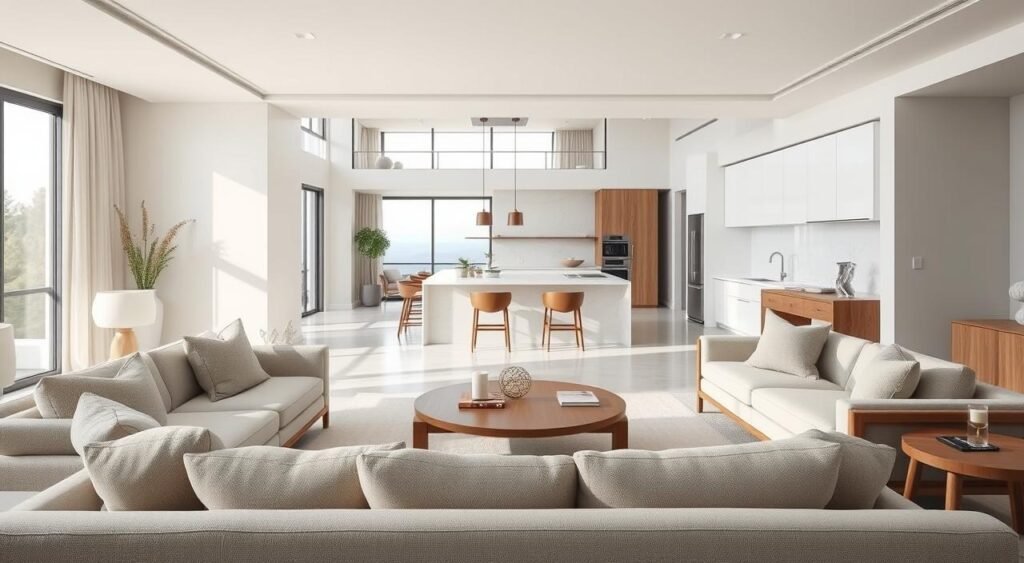
Pro tip: Always test paint samples under your room’s actual lighting. North-facing rooms may need warmer undertones to avoid appearing cold. Mix textures like linen, velvet, and grasscloth to add depth without color overload. Need drama? A sculptural pendant lamp or textured rug instantly elevates any scheme.
Remember—elegant interiors thrive on balance. Combine 60% base color (walls), 30% complementary neutrals (furniture), and 10% accent tones (decor). Trust your eye: If a gray feels “off,” check its undertones against white paper in daylight to spot hidden warmth or coolness.
Warm vs. Cool Neutrals: Choosing Your Base Tones
Deciding between warm or cool tones in your neutral color palette is akin to selecting the essence of your space. It’s about finding the right balance between warmth and purpose. This balance is key to creating a space that feels both intentional and welcoming.
Beiges, Taupes, and Warm Whites
Warm neutrals, such as beige, taupe, and creamy whites, are ideal for creating cozy atmospheres. These hues, with their undertones of yellow, red, or pink, are perfect for areas like living rooms and dining spaces. They encourage conversation and warmth. Pairing them with wood, leather, or brass enhances their inviting nature.
Farrow & Ball’s Green Blue is a notable example of a warm neutral. It adds depth without overwhelming smaller spaces.
Grays, Charcoals, and Cool Whites
Cool neutrals, including grays, charcoals, and whites with blue or green undertones, offer a crisp, modern aesthetic. They are ideal for spaces like sleek kitchens or home offices, where a calm focus is essential. These colors work well with marble, chrome, or matte black finishes for a refined look.
Little Greene’s Shallows gray is a favorite among professionals for its ability to balance coolness with elegance.
How to Pick Your Palette’s Temperature
Choosing between warm and cool tones can be daunting. Here are some questions to guide you:
- What mood do you want? Warm tones create a cozy atmosphere, while cool tones offer a calm, modern feel.
- Consider your room’s orientation. South-facing rooms benefit from cool tones to prevent glare. North-facing rooms can be warmed up with warm tones.
- Think about your furniture style. Mid-century modern pieces often look best with cool tones, while rustic furniture pairs well with warm tones.
Remember, the same “white” wall can appear warm or cool depending on the lighting. Use the 3-step test: apply paint samples, wait 24 hours, and observe them under different lighting conditions.
| Warm Neutrals | Cool Neutrals |
|---|---|
| Beige (Crown Paints’ Flawless) | Gray (Farrow & Ball’s Dove Tale) |
| Taupe (COat Paints’s Modest) | Charcoal (Earthborn’s Tom’s Bakery) |
| Warm white (Little Greene’s Flint) | Cool white (Benjamin Moore’s Cool Star White) |
“Mix 70% warm with 30% cool tones to avoid monotonous spaces,” advises designer Maria Torres. “Even neutrals need contrast!”
Neutrals are not as neutral as they seem. Their undertones significantly impact the overall feel of your space. Choosing the right base tone is simpler than it seems. Start by considering your room’s purpose and the lighting it receives.
Beyond Beige: Exploring the Full Spectrum of Neutral Colors
Neutrals are more than just beige and gray. Modern interior design now includes “new neutrals” like muted sage, dusty blue, and soft terracotta. These colors bring personality while keeping the balance of a neutral color palette for interiors. Let’s explore further:
- Muted greens (like Sherwin-Williams’ Insightful Rose or Behr’s Foxglove) bring nature’s calm without vibrancy.
- Earthy greiges such as Valspar’s Adirondack Path create cozy contrast.
- Soft pastels like Behr’s Plateau or PPG’s Quicksilver add subtle drama.
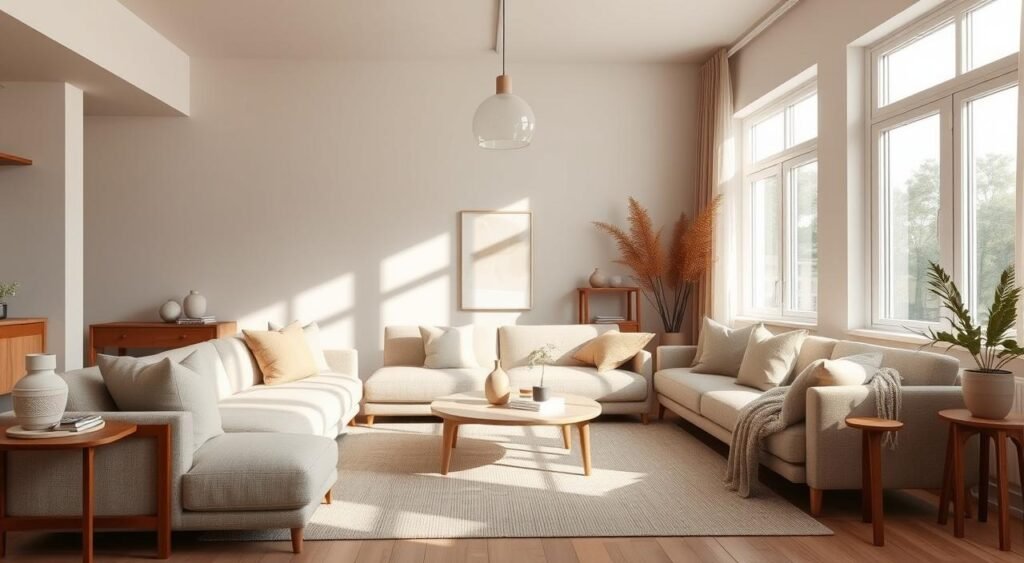
These hues are transformative: 70% of minimalist designs begin with neutrals, as expert research shows. They allow furniture and textures to take center stage, keeping spaces open and serene. Consider Natural Linen by Sherwin-Williams, a modern beige that feels warm yet airy. Or Behr’s First Frost, a blue so tranquil it’s like painting calm onto your walls.
“Neutrals aren’t limits—they’re canvases,” says interior designer Clara Martinez. “A dusty rose wall becomes art when paired with wood tones.”
Ready to experiment? Mix muted hues with warm metals or textured fabrics. Even navy (in low saturation) or muted mauve can anchor a room without overwhelming it. Remember, neutrals are about harmony, not boredom. Your living room could be a spa-like retreat with the right color schemes. And no one will guess you skipped bold reds entirely!
Creating Depth with Monochromatic Neutral Schemes
Ever pondered how to avoid a flat look in a neutral room? Monochromatic schemes can add drama with subtle changes in tone and texture. The secret lies in experimenting with shades, textures, and materials. This transforms minimalist style into elegant interiors that exude life.
Layering Similar Tones for Visual Interest
Neutrals serve as a canvas for nuanced contrasts. Begin with a base shade, like soft ivory walls, and introduce deeper tones with taupe throw pillows or charcoal accent chairs. Even slight variations, such as matte paint against glossy trim, introduce movement. A valuable tip: Employ the same color family but adjust saturation levels. For instance, a cream sofa (light) against a beige rug (medium) and a charcoal area rug (dark) creates depth without overwhelming the space.
The 60-30-10 Rule for Neutral Spaces
| 60% | Primary neutral (walls, large furniture) |
|---|---|
| 30% | Secondary neutral (sofas, larger decor pieces) |
| 10% | Accent neutral (throws, art, lighting) |
Adhere to this ratio to maintain balance. For example, 60% taupe walls + 30% gray upholstery + 10% black metal accents = a harmonious room that feels carefully curated.
Using Texture to Enhance Monochromatic Designs
- Rough linen curtains vs. smooth ceramic vases
- Faux fur throws on sleek marble tables
- Rattan baskets paired with polished wood shelves
Texture is key in transforming a monochromatic space from dull to captivating. Combine matte and glossy surfaces, like matte white walls with a glossy white console table, to reflect light differently. This technique is a game-changer in minimalist style homes, making even the smallest details stand out!
How to Incorporate Subtle Color Accents into Your Neutral Foundation
After establishing a neutral base, it’s time to introduce life without upsetting the balance. These decorating tips reveal how muted hues and strategic color pops can transform your neutral color palette for interiors into a vibrant yet timeless space. Here’s how to make your home decor come alive:
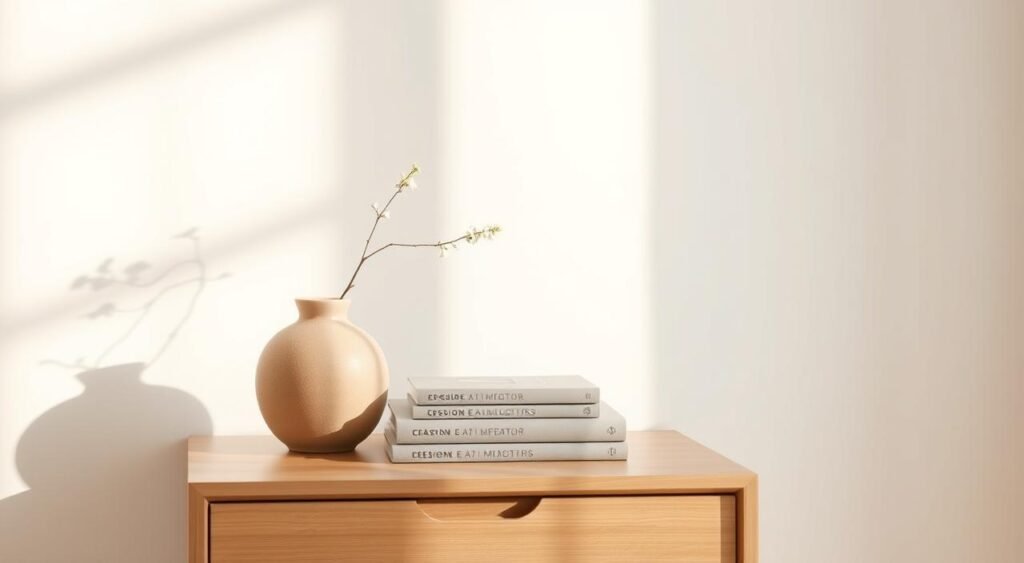
Muted Pastels as Complementary Elements
Consider soft blush, sage, or lavender gray. These low-saturation shades warm up the space without clashing. Try:
- Blue-gray drapes against beige walls
- Blush-toned cushions on a taupe sofa
- Sage-green pottery on a white shelf
Natural Pigments That Maintain Neutrality
Colors like terracotta, moss, or ochre bring a natural feel. Incorporate them through:
- Earthenware vases in terracotta tones
- Wool throws with mossy greens
- Wooden accents in driftwood gray
Strategic Placement for Maximum Impact
Place color where it makes a statement:
- Walls: A single accent wall in deep plum or navy creates drama.
- Furniture: A mustard-yellow chair or sage-green bench adds punch.
- Art: Hang a vibrant abstract piece to draw eyes without overwhelming the room.
Remember, less is more. Swap out accessories seasonally to refresh your home decor effortlessly. Your neutral foundation stays chic—your style stays fresh!
Neutral Palettes for Different Architectural Styles
Ever ponder how a neutral palette can change based on your home’s architecture? Let’s explore how to align your neutral color palette for interiors with your home’s unique style. Whether it’s a modern home or a historic gem, the right neutrals can accentuate your space’s best aspects.
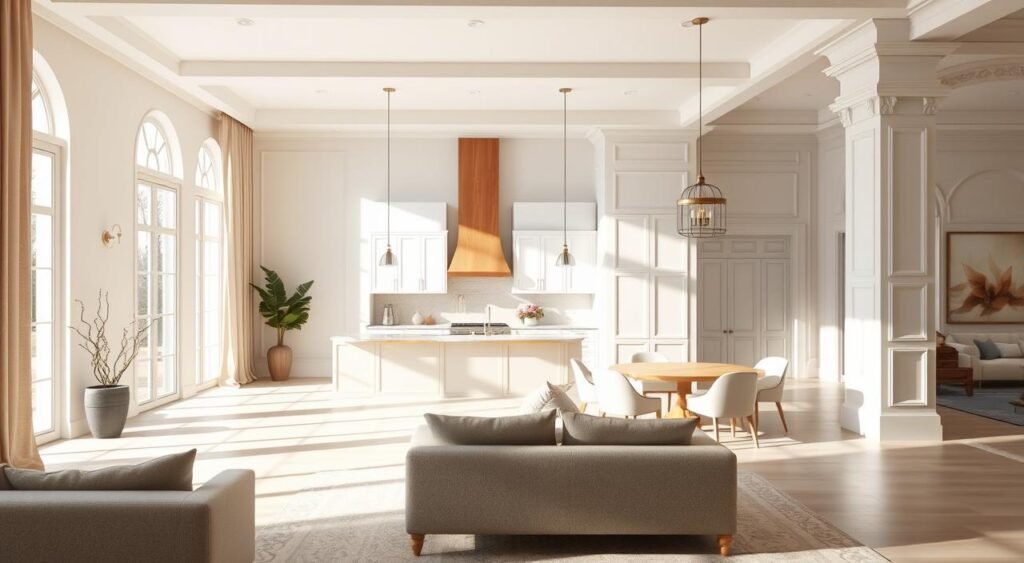
Consider a Craftsman home, for example. Warm neutrals like honeyed beiges and terracotta grays complement its rustic allure. Combine them with exposed wood beams, reminiscent of the modern home transformation of the Mazanka Apartment by Makhno Studio. Their earthy clay walls and linen textiles show that neutrals can be both timeless and contemporary.
- Mid-Century Modern: Opt for sleek grays and whites with a retro flair. The Brisa Home by Volca Interiores incorporates matte black accents and walnut tones to pay homage to 1960s aesthetics.
- Vintage Revivals: For Victorian or Mediterranean homes, use muted creams and pearl whites to soften ornate details. The DT1H1 Apartment by Igor Sirotov Architects strikes a balance between gilded accents and soft off-whites.
- Contemporary Spaces: Bold textures can make neutrals stand out, such as the high-gloss black kitchen in House BK by Caceres + Tous. Combine it with matte concrete for striking contrast.
“Neutrals are the ultimate collaborators—they adapt to your architecture’s personality,” says interior designer Clara Rivera, behind the Yugen House project.
Seeking advice? Begin by identifying your home’s architectural “anchors”—columns, arches, or industrial beams. These elements should guide your base color choice. Next, add textures: linen for farmhouses, metallic finishes for modern lofts. Remember, neutrals are not a one-size-fits-all solution. They are your key to elevating any style.
Material Selection: Complementing Your Neutral Color Scheme
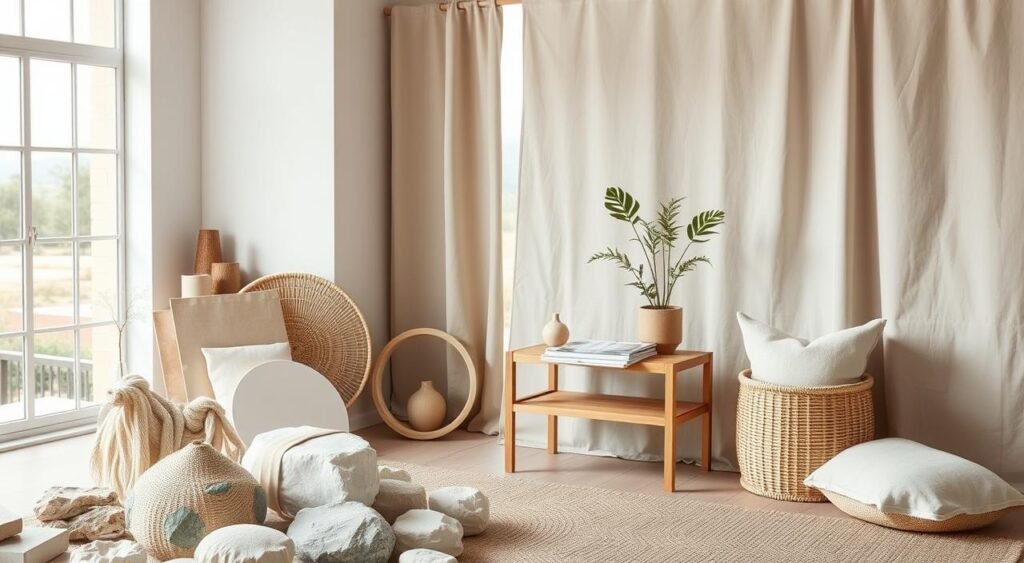
Material choices are the secret sauce for turning neutral spaces into elegant interiors that feel alive. They act as design “accessories,” adding soul without sacrificing simplicity. Here are the top picks to elevate your scheme:
Natural Woods and Their Neutral Companions
Wood is your best friend for warmth. Try these combos:
- Pair honey oak with cream walls for a sunlit cottage vibe.
- Use walnut against cool grays to add depth.
- Go rustic with reclaimed pine for an earthy touch.
Pro tip: Mix wood tones! Pale ash flooring with a dark-stained coffee table creates instant visual interest. And if you’re DIY-savvy, upcycling old furniture with wood finishes is a budget-friendly way to add texture—check out 17vibes’ guide for easy woodwork hacks.
Metallics That Elevate Your Neutrals
Metal accents act as the “bling” in neutral rooms. Play with:
- Brass for a warm glow against white or beige walls.
- Chrome or stainless steel for a crisp modern look.
- Copper pendants or nickel hardware to add subtle shine.
Rule of thumb: Stick to 1-2 metal tones per room to keep the space cohesive. Even a single gold-framed mirror can anchor a neutral scheme!
Stone, Concrete, and Earthy Textures
Mineral materials like marble or concrete add architectural drama. Try:
- Terracotta tiles for a sunlit Mediterranean feel.
- Marble countertops to add veined elegance.
- Rough-hewn stone walls for a rugged contrast.
Pair raw concrete with soft linen textiles to balance the industrial edge. These materials don’t just add texture—they become the star of your interior inspiration!
Remember: Materials are your neutrals’ best accessory. Mix woods, metals, and stone thoughtfully, and watch your space bloom with purposeful style.
Room-by-Room Guide to Applying Neutral Color Palettes
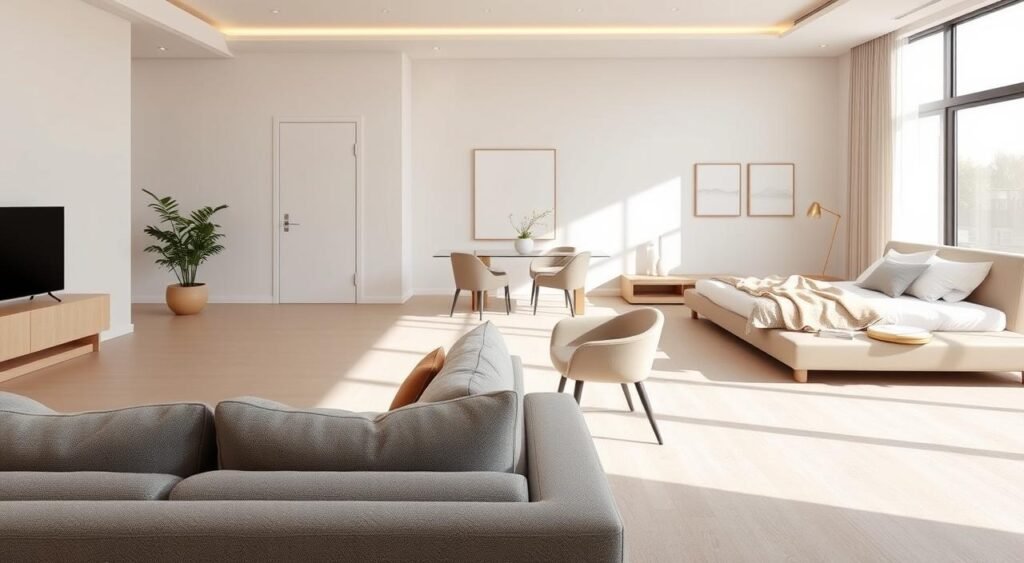
Let’s turn neutral theory into action! Every room needs its own touch of warmth or calm—here’s how to customize neutrals for each space:
Living Spaces: Creating Conversation-Friendly Neutrals
Begin with light neutrals like oatmeal or pale gray walls. Add texture with chunky knit throws or woven jute rugs. A large-scale neutral rug (think ivory or charcoal) instantly anchors seating areas. Mix linen upholstery with velvet accents to keep things lively yet low-key. Pro tip: Add a gallery wall of black-and-white prints to add visual interest without color.
Bedrooms: Restful Retreats Makeovers
Opt for warm neutrals like sand or almond for walls. Layer in soft textures—fluffy white bedding, a faux fur throw, or nubby cotton curtains. Add subtle color pops via blush-hued pillows or sage green plants. A velvet headboard adds richness without overwhelming the space. Need drama? A deep charcoal accent wall creates contrast against light walls.
Kitchens & Dining: Function Meets Style
Warm neutrals like cream or pale gray create a welcoming backdrop. Use natural wood cabinetry or marble countertops for a French Country vibe—mixing warm and cool tones adds depth. A navy-blue or terracotta tile backsplash adds character without breaking the neutral foundation. Dining rooms gain warmth with a dark wood table paired with off-white walls.
Bathrooms: Spa Vibes on a Budget
Choose light neutrals like cloud white or misty gray for walls. Add spa-like luxury with textured towels, marble sinks, or hexagonal tile patterns. Stick to one metallic (brass or nickel) for fixtures. A small area rug in jute or wool adds coziness. Layer with plants or linen curtains for a fresh feel.
Remember—texture is your best friend! Swap out decor seasonally with throw pillows or art to refresh spaces effortlessly. Neutral design isn’t boring—it’s a canvas for creativity!
Lighting Considerations for Neutral Interiors
Lighting is key to transforming neutral spaces into something extraordinary. Let’s dive into how light can enhance your modern home’s design. Begin by evaluating your natural light sources—sunlight significantly impacts how neutrals look at different times of day.
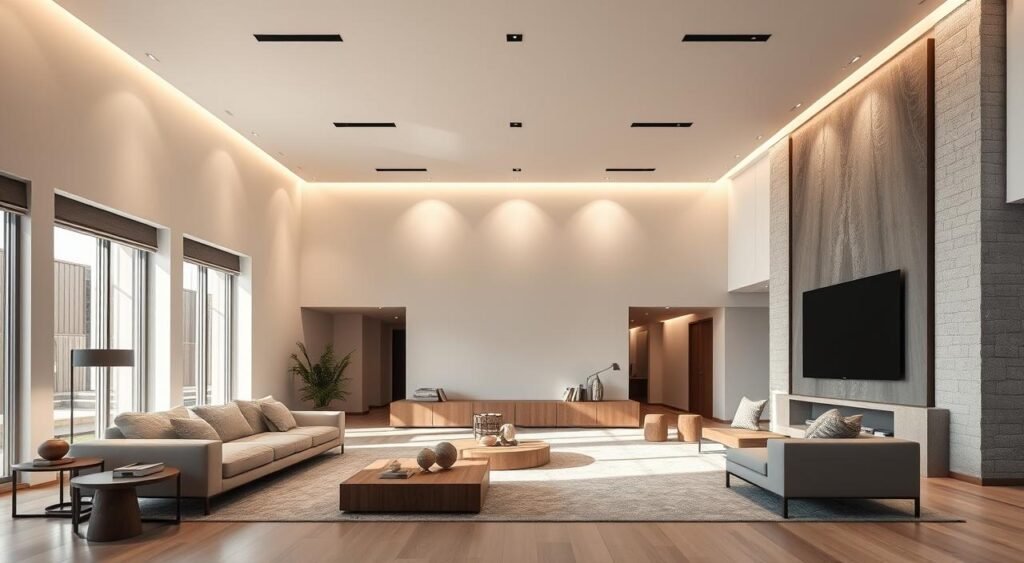
- North-facing rooms: Opt for warm tones like Yellow Ground or darker neutrals to counteract cool daylight.
- South-facing spaces thrive with soft blues or warm neutrals to maximize brightness.
- West-facing areas need chameleon shades like Middleton Pink to adapt to shifting afternoon light.
- East-facing rooms pair morning sun with bright neutrals like Breakfast Room Green for daytime vibrancy.
For artificial lighting, layer three styles: ambient (recessed lights), task (table lamps), and swing-arm fixtures), and accent lights for focal points. Use 2700K-3000K bulbs for cozy warmth—try dimmers to adjust moods. LED options keep costs low while maintaining style.
Pro tip: Mix neutral-white bulbs (4000K) in kitchens for accurate color representation. Add a standout fixture like a chandelier to turn a blank wall into interior inspiration. Smart systems let you customize scenes for movie nights or dinner parties.
Lighting isn’t just functional—it’s your secret weapon for making neutrals feel dynamic. Ready to see your space glow? Start experimenting with layered light today!
Seasonal Adaptations for Your Neutral Home
Ever wondered how to refresh your neutral space without a full redesign? Let’s explore easy decorating tips to keep your home decor feeling fresh year-round. Whether it’s winter’s coziness or summer’s brightness, your neutral palette is the perfect canvas for seasonal updates!
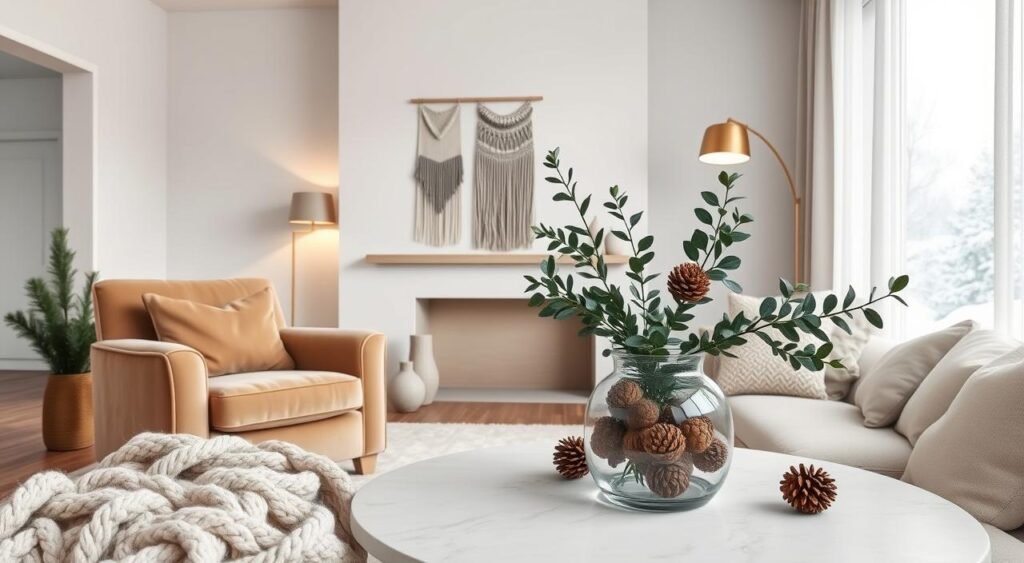
Winter Warmth in Neutral Spaces
Bring winter’s coziness in with layered textures and rich accents. Try:
- Velvet throws and faux fur rugs for tactile warmth
- Brass or copper accents to add golden warmth
- Candle warmers with cinnamon or cedarwood scents
- Potted poinsettias or dried eucalyptus arrangements
Summer Freshness Without Breaking the Neutral Scheme
Lighten your space with airy fabrics and botanicals. Think:
- Linens and cotton blends in pale blues or mint greens
- Fresh flowers like white lilies or potted herbs
- Ice blue glass vases or terrariums
- Cozy outdoor cushions in natural jute or linen
“Neutrals are the foundation—seasonal touches are just the cherry on top.”
Transitional Touches for Spring and Fall
| Spring | Fall |
|---|---|
| Soft pastels like blush pink or sage | Deep tones like burnt orange or forest green |
| Floral patterns in cotton or linen | Textured wool throws or woven baskets |
| Potted succulents or air plants | Dried seed pods or gourds |
Small swaps like these let you embrace the season while keeping your interior inspiration cohesive. Mix in natural elements like pinecones or sunflowers to tie the indoors to the outdoors!
Common Mistakes to Avoid When Designing with Neutrals
Even the most meticulous interior design plans can falter when neutrals lack life. Here are some decorating tips to ensure your neutral color palette for interiors is deliberate, not haphazard.
The “Too Flat” Syndrome and How to Avoid It
A room that feels like a blank canvas? It’s time to add layers.
- Mix textures: Combine smooth marble with woven baskets or linen curtains.
- Spotlight contrast: Introduce a matte-black side table or a warm wood accent to break the monotony.
- Play with depth: A charcoal-gray sofa against a cream wall adds instant drama.
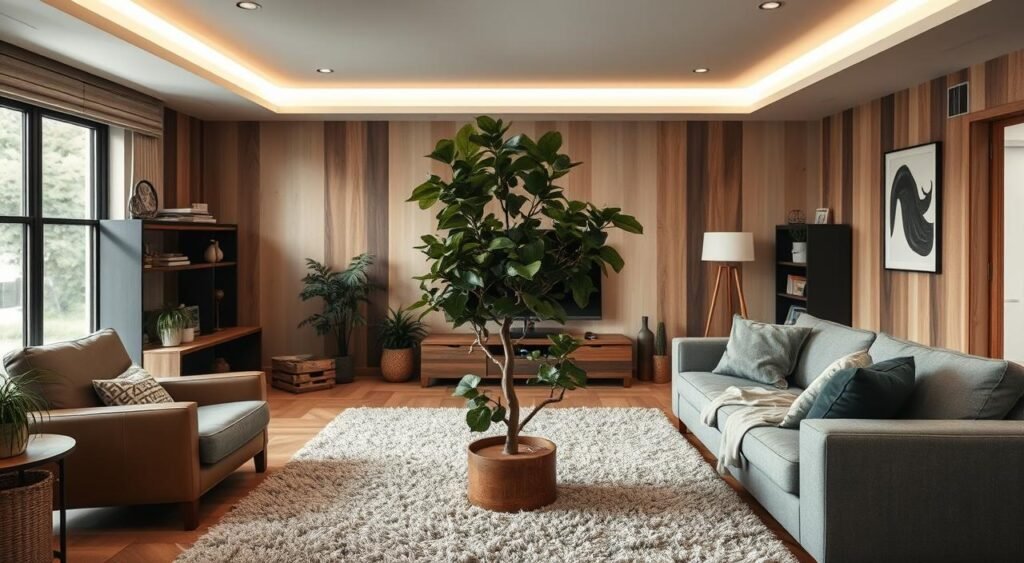
Balancing Warm and Cool Elements
Too much cool grays? A single warm wood accent, like a walnut coffee table, can rebalance the room. Here’s how to achieve harmony:
- Pair warm woods with cool metals—brass and steel complement each other well.
- Test fabric warmth: A terrycot throw on a gray couch adds coziness without adding color.
When “Less is More” Becomes “Not Enough”
A minimalist neutral color palette for interiors shouldn’t feel empty. Add life with:
- Small art pieces: A framed in black or matte white frames adds focal points.
- Textural depth: Fuzzy rugs or basketweave blankets create visual interest.
Remember—neutral spaces thrive on contrast and layers. Your home is more than just walls; it’s a blend of materials, light, and lived-in details. Trust your eye and experiment fearlessly!
Designer Insights: Professional Tips for Perfecting Your Neutral Palette
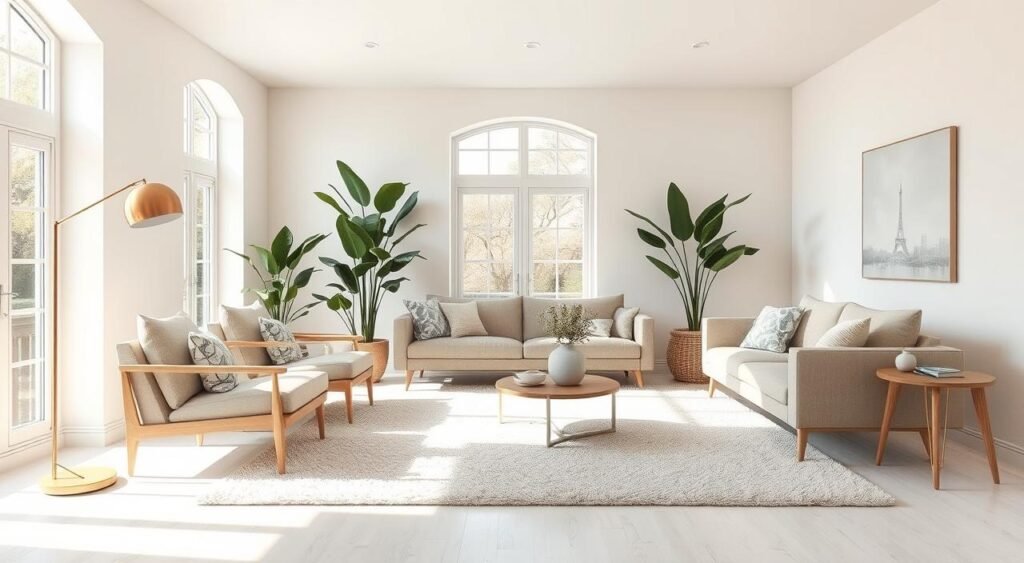
Ever wondered how pros transform neutral spaces into elegant interiors that exude both timelessness and personal touch? Let’s explore the secrets from top interior design experts:
- Begin with a “color story.” Create a mood board featuring textures, materials, and subtle accents. View your palette as a narrative—warm grays for coziness, or cool whites for minimalism.
- Layer neutrals like an artist. Combine matte, glossy, and metallic finishes. A linen sofa against textured wallpaper adds depth without color.
- Lighting should be your co-designer. Soft lamplight warms grays; skylights make whites glow. Test shades at different times of day!
“The magic happens when neutrals aren’t just colors—they’re a canvas for art, light, and life,” says Havenly’s Toussaint Derby. “Add a vintage vase or a wool throw—small moves make neutrals feel lived-in.”
Pro hack? Adhere to the 60-30-10 rule for interior inspiration: 60% base neutral (like taupe walls), 30% secondary (wood floors), 10% metallic accents. Pair with:
- Warm undertones (creamy whites over stark ones) for approachable spaces
- Textured rugs or linen curtains to avoid flatness
- 1-2 bold accent pieces (a cobalt vase, terracotta planter) to spark interest
Stuck? Look to your wardrobe. What neutrals make you feel calm? Replicate that in your home. Remember—elegance isn’t about rules, it’s about balance. Now go mix, layer, and make those neutrals sing!
Conclusion: Creating Your Timeless Neutral Sanctuary
A neutral color palette for interiors is more than just safe choices. It’s a starting point for modern home design that’s both thoughtful and easy. By mixing warm and cool tones, adding textures, and using light wisely, you create a space that adapts to your life. Picture a living room with Benjamin Moore’s Silver Satin walls and a sleek beige sofa. This minimalist base becomes richer with each throw blanket or piece of art you add.
Neutral palettes are all about simplicity, yet they’re far from dull. Grays or taupes with complex undertones add a touch of drama. Textures like linen or stone bring warmth to the touch. Even small updates, like a new lampshade or a textured pillow, can transform your space without a big expense. This philosophy aligns with designers like Brigette Romanek, who create spaces that are both stylish and welcoming.
Begin with a single room and test samples to build your confidence. Neutral colors allow your personal style to stand out through thoughtful accents. Whether you dream of a serene bathroom or a cozy living area, these palettes keep your home looking fresh for years. Remember, a timeless neutral sanctuary is a space that evolves with you. Are you ready to start? Choose your base color today and see elegance unfold naturally.
FAQ
What are some examples of neutral colors beyond beige and gray?
Neutral colors extend beyond beige and gray to include muted tones like sage green and dusty blue. Terracotta and pale blush also fit into this category. These unexpected hues add sophistication to any space, creating a calm and elegant atmosphere.
How do neutral colors influence the mood of a space?
Neutral colors can significantly impact a space’s mood. They create a calming atmosphere, reducing visual noise and promoting wellness. Warm neutrals can make a space feel cozy, while cooler tones bring serenity, depending on the design intent.
How can I choose between warm and cool neutrals for my home?
Choosing between warm and cool neutrals depends on the space’s natural light and desired mood. Warm neutrals are often better for north-facing rooms to counteract cool light. In contrast, south-facing spaces can benefit from cooler tones.
What is the 60-30-10 rule, and how does it apply to neutral spaces?
The 60-30-10 rule suggests a room should be 60% a dominant color (like a neutral base), 30% a secondary color, and 10% an accent color. This guideline helps maintain balance and visual interest in neutral interiors.
How can I add texture to a neutral design without introducing color?
To add texture without color, use various materials like linen, velvet, wood, and stone. Combining these textures adds depth and interest to a monochromatic neutral space.
What materials should I consider for a neutral color scheme?
For a neutral color scheme, consider natural woods, metals (such as brass or chrome), and mineral-based materials (like marble and concrete). Each material offers subtle variations that complement your neutral palette beautifully.
How can I adapt my neutral home decor for the seasons?
For winter, add warm textiles and deeper accent colors. In summer, use airy fabrics and botanical elements. For spring and fall, introduce subtle pastels or rich earth tones to refresh your spaces.
What common mistakes should I avoid when designing with neutrals?
Avoid a “too flat” look by incorporating varied textures. Be mindful of temperature balance, introducing touches of the opposite temperature for harmony. Ensure your space feels complete by adding enough design elements.
What are some tips from designers for perfecting neutral spaces?
Designers suggest creating “color stories” within neutral palettes to highlight architecture and art. Use neutrals strategically to maintain a cohesive look while allowing for personal expression through subtle details.
